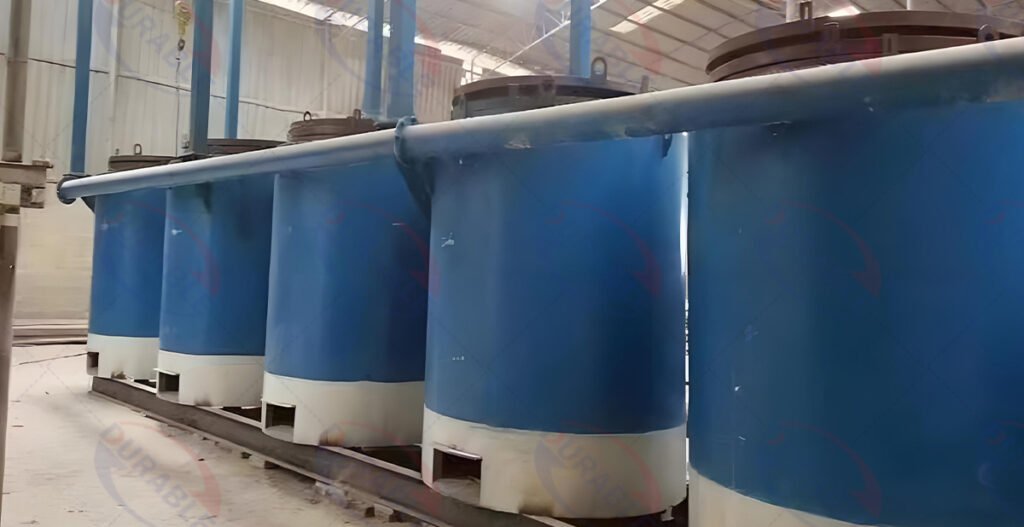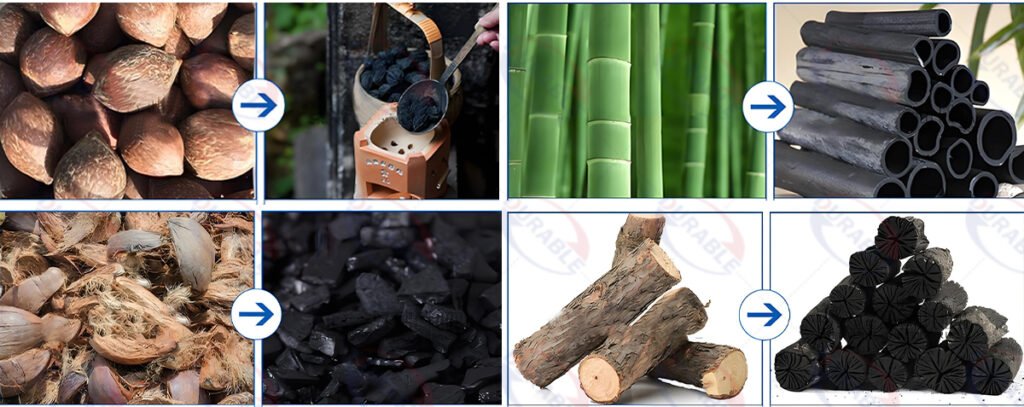Unlock Quality with a Vertical Carbonization Furnace
At Durable, we talk to charcoal producers every day. Many are struggling with traditional earth kilns. They face pressure from environmental agencies due to heavy smoke, and they lose profit because of low, inconsistent yields. You might be wondering if there is a better way. The answer is yes. A modern vertical charcoal furnace is not just an upgrade; it’s a complete change in how you think about charcoal production. It’s engineered to solve the biggest problems of traditional methods, helping you produce more, higher-quality charcoal, all while meeting strict environmental standards.

Table of Contents
- How Much Can My Charcoal Output Increase?
- Can I Truly Achieve “Smokeless” Production?
- How Many People and How Much Time Does It Take?
- What Raw Materials Can I Use?
- Can I Earn Extra Income from Byproducts?
- How Good is the Final Charcoal Quality?
- What is My Return on Investment (ROI)?
- Conclusion: A Smarter Investment for Modern Production
- About Durable
How Much Can My Charcoal Output Increase?
This is the most important question for any investor. A vertical carbonization furnace dramatically improves your yield compared to a traditional earth kiln.
The difference is based on simple science. A traditional kiln is very inefficient. It burns part of the wood itself to create heat, and a huge amount of energy is lost to the air. This results in a high wood-to-charcoal ratio, often 5:1 or even worse (it takes 5 tons of wood to make 1 ton of charcoal). A vertical charcoal furnace is a sealed, highly efficient chemical reactor. It uses an external heat source and its own recycled syngas for energy. This means almost all of your raw material is converted into charcoal. You can expect a conversion ratio of around 3:1, effectively doubling your output from the same amount of raw material.
Let’s put that in perspective. With 30 tons of wood, a traditional kiln might give you 6 tons of charcoal. A vertical furnace will give you 10 tons. That’s 4 extra tons of product to sell, every single cycle.
Can I Truly Achieve “Smokeless” Production?
Yes, but it’s not magic—it’s smart engineering. The term “smokeless carbonization furnace” can be misleading. The process of heating wood (pyrolysis) always produces smoke. This smoke is actually a flammable gas called syngas, which contains wood tar, methane, and other combustibles.
Here’s how a vertical furnace achieves a “smokeless” operation:
- Syngas Capture: Instead of releasing this smoke into the atmosphere, the furnace captures 100% of it in a sealed system.
- Purification: The gas is passed through a purification system that condenses and removes the wood tar and wood vinegar.
- Recycling as Fuel: The cleaned, flammable syngas is then piped back to the furnace’s combustion chamber. It becomes the primary fuel source to continue the carbonization process.
Once the furnace reaches its operating temperature, it essentially powers itself. You eliminate air pollution because you are burning the “smoke” as fuel instead of releasing it. This makes it an eco-friendly carbonization furnace that can meet even the strictest environmental regulations.
How Many People and How Much Time Does It Take?
This is where you see a huge difference in operational efficiency and labor costs.
A traditional kiln is a labor-intensive, batch process. It requires multiple workers for loading, constant monitoring for days or weeks, and then a difficult, dirty unloading process. In contrast, a vertical furnace is designed for continuous operation. Raw material is fed in from the top, and finished charcoal is discharged from the bottom, all automatically. Once the system is running stably, it can operate 24/7 with minimal supervision. A single operator can typically oversee the entire process from a control panel.
The carbonization process itself is also much faster. Instead of waiting days, the residence time of material inside the furnace is just a few hours. This means you can go from raw wood to finished, bagged charcoal in a single day.
| Feature | Traditional Earth Kiln | Vertical Carbonization Furnace |
|---|---|---|
| Cycle Time | 5 – 20 days | Continuous (24/7 operation) |
| Labor Required | 3-5 people (intensive) | 1 person (supervisory) |
| Output | Inconsistent batches | Continuous, predictable flow |
| Work Environment | Hot, smoky, hazardous | Clean, controlled |
What Raw Materials Can I Use?
While wood is common, a vertical furnace can handle a wide range of biomass carbonization. However, there is a critical rule: the material must have a uniform size and low moisture content.

The furnace relies on gravity for the material to flow smoothly from top to bottom.
- Ideal Materials: Wood chips, coconut shells, palm kernel shells, fruit pits, and bamboo chunks. The ideal size is between 2cm and 5cm.
- Unsuitable Materials (Directly): Sawdust, rice husks, straw, and other fine powders or flaky materials. These will clog the furnace.
- The Solution: If you want to use fine materials, you must first process them using a biomass briquette machine. This turns the loose powder into dense, uniformly sized briquettes, which are an excellent feedstock for the furnace.
Your raw material must also be dry, ideally with a moisture content below 15%. If your material is wet, you will need to invest in a sawdust dryer first. Trying to carbonize wet material will drastically lower your efficiency, as most of the energy will be wasted just boiling off water.
Can I Earn Extra Income from Byproducts?
Absolutely. The wood vinegar (pyroligneous acid) and wood tar collected during the syngas purification process are valuable commercial products. This creates an additional revenue stream that traditional kiln owners miss out on.
- Wood Vinegar: This is a liquid byproduct used as a natural pesticide, fertilizer, and plant growth promoter in organic farming. It is in high demand in the agriculture sector.
- Wood Tar: This thick, dark liquid has various industrial uses, including as a wood preservative, in the production of chemicals, and as a binder.
By collecting and selling these byproducts, you can significantly improve the overall profitability of your charcoal operation. A well-designed system can recover roughly 200-300 kg of wood vinegar for every ton of charcoal produced.
How Good is the Final Charcoal Quality?
The quality of charcoal from a vertical furnace is consistently higher and more controllable than from a traditional kiln. The key is precise control over temperature and residence time.
By adjusting the discharge rate at the bottom of the furnace, you control how long the material stays in the high-temperature zone.
- For High-Quality BBQ Charcoal: You can use a slightly lower temperature (around 450-550°C). This produces charcoal with a higher volatile matter content, which makes it easy to light and burn steadily.
- For Industrial or Activated Charcoal: You can increase the temperature (600°C and above). This results in charcoal with a very high fixed carbon content (often over 90%), making it harder, denser, and suitable for industrial applications.
Because the process is continuous and controlled, every piece of charcoal that comes out has undergone the exact same process, ensuring a uniform quality that commands a higher price in the market.
What is My Return on Investment (ROI)?
While the initial investment for a vertical charcoal furnace is higher than building a simple earth kiln, the return on investment is much faster.
Your payback period is accelerated by several factors:
- Higher Yield: You produce nearly double the charcoal from the same amount of raw material.
- Lower Labor Costs: Continuous, automated operation requires far fewer workers.
- Zero Fuel Cost: After startup, the furnace powers itself using its own recycled syngas.
- Byproduct Sales: Extra income from selling wood vinegar and tar.
- Higher Product Value: Consistent, high-quality charcoal sells for a premium price.
- Continuous Production: You are producing and selling product every day, not just once every few weeks.
For many of our clients, the increased profit and operational savings lead to a full return on their investment in as little as 12 to 18 months.
Conclusion: A Smarter Investment for Modern Production
Moving from a traditional kiln to a vertical carbonization furnace is a strategic business decision. You are choosing a path of higher efficiency, environmental compliance, and greater profitability. It is an investment in a system that eliminates smoke, doubles your yield, reduces labor, and creates multiple streams of income. It is the modern solution for serious charcoal production.
About Durable
At Durable, we specialize in providing robust, industrial-grade solutions for biomass processing. Our vertical hoist biomass carbonization furnace is engineered for reliability and high performance, using heat-resistant materials like 310S stainless steel in critical areas to ensure a long service life. We don’t just sell equipment; we provide complete, engineered solutions that turn your biomass waste into high-value products.
Contact our engineering team to discuss your project and discover how we can help you build a profitable, modern charcoal business.
 Durable Machinery
Durable Machinery